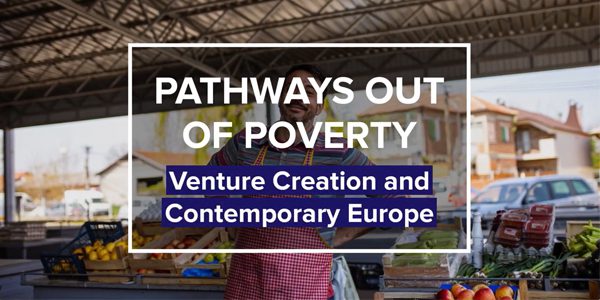Beyond the Border: Navigating the paths to migration
Subscribe to the ThinkND podcast on Apple, Spotify, or Google.
Featured Speakers:
- Tom Hare, Senior Technical Associate, Pulte Institute for Global Development
- Abby Córdova, Associate Professor of Global Affairs, Keough School of Global Affairs
- María Estela Rivero Fuentes, SHARE MEL-KM Director, Pulte Institute for Global Development
Ray Offenheiser, director of the Pulte Institute for Global Development, welcomed participants to Week 1 of the Beyond the Border series. He noted that the topic of migration is of particular interest to the work of the Pulte Institute to bridge the gap between research and policy. Recently, the Pulte Institute created the Central America Research Alliance (CARA) to build a partnership network that focuses on evidence-based advocacy in the region. The goal with this series – and more broadly with CARA – is to use evidence to put the issue of migration and development in the region into context, and to give special priority to marginalized voices from Central America. The Pulte Institute has partnered with the Kellogg Institute for International Studies — one of its sister institutes in the Keough School of Global Affairs — to bring these discussions to life through the lens of integral human development. By making these issues surrounding migration more accessible, said Offenheiser, he hopes we can spur action for meaningful change.
Offenheiser then welcomed Dr. Tom Hare, a senior researcher with the Pulte Institute and co-director of CARA. Dr. Hare has worked in and on Central America for the last twenty years where he has developed, implemented, and evaluated international development programs with a focus on rule of law and human rights.
Dr. Hare shared his personal story of how he became interested in Central America. He first experienced the region as an exchange student at the University of Central America in San Salvador. He painted a picture of a young Dr. Hare riding the bus from Mexico, through Guatemala to San Salvador — basically doing the typical migration route in reverse — passing volcanos, farms, cities, and people — just taking in the beauty of it all from the bus window. He said he knew then that there was something special about the region but only realized why after he became friends with students and others in some of the most marginalized communities around Sand Salvador.
Dr. Hare introduced his guests to discuss realities in Central America that often force people to migrate: Dr. Estela Rivero Fuentes, the Monitoring, Evaluation, Learning, and Knowledge Management Director for the USAID-funded Supporting Holistic and Actionable Research in Education (SHARE) program and his co-director at the Central America Research Alliance; and Dr. Abby Córdova, an associate professor of global affairs in the Keough School of Global Affairs, a faculty fellow of the Kellogg Institute for International Studies, and a research affiliate of the Kellogg Institute’s Notre Dame Violence and Transitional Justice Lab (V-TJ).
Dr. Hare began the discussion by asking each speaker how they became interested in their topics of study and if there was a formative moment in their lives that led them to this work. Dr. Córdova shared that her interest in political science came from her experience growing up during a civil war in El Salvador, while Dr. Rivero Fuentes said her first published paper on migration was inspired by the Mexican workers she met whilst studying at Princeton.
Over the years, Dr. Rivero Fuentes has done a lot of work on migration and internal displacement in both Mexico and Central America, and she has spent the better part of the past three years working on understanding migration from Central America, and Honduras in particular. She noted that it is not just economic reasons or violence alone, but numerous factors that influence migration intentions. In early 2021, she did a nationally representative survey among Hondurans, and asked them about their migration intentions. She explained that a representative sample means that we can reliably extrapolate the findings to the whole country. It was found that 50% of those interviewed would like to migrate within the next three years, with 2 in every five wanting to move to the US. When asked what their reasons were for wanting to leave their country, a little more than 9 in every ten said that they had economic motives. Dr. Rivero Fuentes went on to say that in addition to the economic reasons, half of them said that they wanted to leave because of violence, and a little less than that wanted to leave Honduras because of environmental, political, or family reasons.
Dr. Hare turned to Dr. Córdova, who has dedicated a lot of time to helping unpack the root causes of migration, especially violence such as gender-based violence. Dr. Córdova highlighted that 63% of Hondurans and El Salvadorans have experienced violence in their life, and 50% experience it in the home. Particularly in countries controlled by guns, citizens have experienced violence from the police or the military and are therefore less likely to report this violence. In 2020, 25% of women cited violence as their primary reason for migrating, compared to only 15% of men.
Overall in the region, there is also a collective concern about the strength of democratic institutions. Dr. Córdova noted that, overall, democracy has declined in the region – with El Salvador declining the fastest. An August 2021 survey revealed that 42% of El Salvadorans would migrate if the government were to adopt Bitcoin as a legal currency, a sure sign of instability. The political oppression of those who criticize the government in El Salvador shows that it is going down a similar path to Nicaragua, which is not rated as a free country.
Dr. Rivero Fuentes stated that youth should be a group of special interest in any effort to improve the quality and dignity of life. In her study in Honduras, those in the 18 to 30-year-old range had 23% higher intentions of migrating than those 31 and older. In another national survey, Dr. Rivero Fuentes found that about 40% of respondents were employed but still food insecure. Employment skills must be improved, but these interventions need to be paired with larger structural changes that provide good quality, long-term employment. It is not only having a job, but having a good quality one that makes people flourish where they live.
To wrap up, Dr. Hare asked each guest what gave them hope. Dr. Córdova said he sees many citizens and organizations standing up to defend democracy in the region through peaceful protests and the demand for transparency. Dr. Rivero Fuentes finished by noting that migration is not easy and no one wants to do it. When people are happy and secure, they are 88% less likely to migrate.
- Numerous factors influence migration. In a nationally representative survey among Hondurans, 50% said they would like to migrate within the next three years, with 2 in every five wanting to move to the US. When asked what their reasons were for wanting to leave their country, they identified multiple motivations for leaving, including economic, violent, political, and family reasons.
- 63% of Hondurans and El Salvadorans have experienced violence in their life, and 50% experience it in the home. Particularly in countries controlled by guns, citizens have experienced violence from the police or the military and are therefore less likely to report this violence. In 2020, 25% of women cited violence as their primary reason for migrating, compared to only 15% of men.
- Overall, democracy has declined in the region. An August 2021 survey revealed that 42% of El Salvadorans would migrate if the government were to adopt Bitcoin as a legal currency, a sure sign of instability.
- It is not only having a job but having a good quality one that makes people flourish where they live. Those in the 18 to 30-year-old range had 23% higher intentions of migrating than those 31 and older. Yet many who had jobs were still food insecure. Employment skills must be improved, but these interventions need to be paired with larger structural changes that provide good quality, long-term employment.
- Migration is not easy and no one wants to do it. When people are happy and secure, they are 88% less likely to migrate.
- “Early in 2021 we did a nationally-representative survey among Hondurans, and asked them about their migration intentions. A representative sample means that we can reliably extrapolate the findings to the whole country…When we asked them what were the reasons for wanting to leave their country, a little more than 9 in every ten told us that they had economic motives…People have multiple motives. In addition to the economic reasons, half of them said that they wanted to leave because of violence, and a little less than that wanted to leave Honduras because of environmental and political reasons, while one in every three also mentioned that they want to migrate because of family reasons.” [Mária Estela Rivero Fuentes, 20:57]
- “We have found, by comparing this kind of surveys over time and in some other studies where we followed a group of youth for at least six months, that the importance of each of these factors has been changing. For example, in the evaluation of a vocational training program in Honduras, we interviewed participants at the beginning of the program, in 2019, and then six months after. The first time we interviewed participants, most said that they wanted to migrate because they did not have a job. When we reinterviewed them, unemployment was still the main reason for wanting to migrate, but feeling unsafe because of violence, and the idea that even when they had a job, they’d earn more in the US had become very important as well.” [Mária Estela Rivero Fuentes, 23:10]
- “In general, across the world, gender-based violence is more prevalent in Latin America and Africa. One of the unfortunate indicators we can look at is the killing of women because of their gender. unfortunately, the two countries in Latin America or femicide rates are Honduras and El Salvador.” [Abby Córdova, 25:57]
- “A higher percentage of women have consistently, over the past 7 years, have been more likely to cite insecurity as the main reason for migrating compared to men. During the pandemic, the percentage of both men and women citing insecurity as the reason for migrating went up. Over time, we are seeing a higher percentage of people migrating due to violence.” [Abby Córdova, 29:30]
- “If we examine the trajectory of democracy in Central America, what we see is that democracy has declined in El Salvador, Guatemala, and Honduras in the past few years. Currently, El Salvador is showing the fastest declining democracy according to different indexes. This has created a lot of political uncertainty.” [Abby Córdova, 34:00]
- “About what works to improve living conditions. One key area is to improve employment skills, but these interventions need to be paired with larger structural changes that provide good quality, long term employment.” [Mária Estela Rivero Fuentes, 38:38]
Related Content
The Future of Work
November 30, 2023 marks one year into the ChatGPT era and one of the most pressing concerns we hear from all quarters is: How will this affect the future of work and what the...
View EventPathways Out of Poverty
The question of entrepreneurship as part of the solution to global poverty is receiving increasing attention from scholars, economic development professionals, government...
watch videoDisidencia sexual y de género en Gabriela Mistral / Gender and Sexual Dissidence in Gabriela Mistral
Offered in Spanish and English with simultaneous interpretation. Claudia Cabello-HuttAssociate Professor of SpanishDirector of Graduate StudiesThe University of North Carolina at...
View Event


